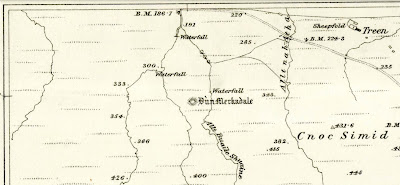 |
| Beverly Marshall Saling |
Evadne's a Lelegian Greek, born and raised in Ortygia Grove west of Ephesus. The daughter of a goat herder, Evadne grew up herding, hunting, and exploring her native woods and mountains until she was unexpectedly struck with cyclic moon madness.
At the New Moon, she's brilliant but foolish (intelligence 20, wisdom 8), but at the Full Moon she's wise but stupid (wisdom 20, intelligence 8), and she cycles back and forth. Under the 13th Age rules, this is her One Unique Thing, that she was "gifted" unwilling with this divine favor from the Greek goddess Artemis. Sometimes at the Full Moon she's even possessed by Artemis.
 |
| Facial Features |
There have been other Moon-touched priestesses of Artemis from time to time over the millennia, but never more than one at a time, and never an unwilling one. Artemis sees something special in Evadne, but Evadne is powerfully ambivalent about Her favor. More specifically, her feelings about her calling are cyclic. The wiser she is, the more she loves serving Artemis and is filled with deep intuitions. The smarter she is, the more she hates her service, sometimes in a fey, mischievous, or self-destructive way.
The Change rendered her fit only half the time to herd goats. The other half, when she wasn't making foolish choices, the goats were outsmarting her. Her family found refuge for her in the service of Artemis, where her affliction was revealed to be of divine cause. As the Greeks knew, it's a terrible thing to be a favorite of the gods. She moved to the sacred isle of Delos, where Artemis's priestesses taught her to harness her mental oscillations and to summon the Goddess's powers at need to serve sacred causes, growing into a Goddess-touched priestess and oracle.
 |
| Artemis |
Evadne's situation under the Byzantines in Englandia is very different from what it would have been in our world. Following the principles Beverly and I established in the late 1990s, Englandia's history deviates from ours in the ways that must inevitably follow if the supernatural and the divine worked for each culture how that culture historically thought it did. This means that, contrary to monotheism's core cosmological principal in our world, in the imaginary game world of Englandia, every ghost and goblin, demigod or goddess, actually does exist more or less in the ways they were believed to.
 |
| Evadne's Archery Kit |
In Englandia's history, the Romans and Byzantines never fully eliminated the Olympian religion, because the Olympian deities are real in Englandia. Though the Pagan Greeks were pushed back to the strongholds of their sacred sites, they could not be eliminated, because their deities could neither be disproven as myths nor defeated as mere demons. As actual (well, imaginary) deities, they held their own, and their believers survived down the centuries.
One pattern in Englandia for resolving such clashes is that it's hard on empires. The farther would-be conquerors get from their own centers of magic and sacred places, the weaker their influence. The closer conquerors come to their opposition's sacred places, the fiercer the resistance. So in the world Evadne grew up in, Olympian Greek culture was pushed back but survived.
 |
| Zephyr and Zoë and friend |
Once trained, she set out into the world as an international artifact retriever. Accompanied by her two Hellenic hounds, Zephyr and Zoë, she follows leads from chronicles, folk memories, and legends to guide her toward her people's stolen ancient relics. When she finds them, she "liberates" them and brings them back home to her people's sacred places.
Her current investigation took her farther from home than ever, to the British Isles, first to York to study ancient inscriptions, then up into the wilds of Scotland, north of Hadrian's Wall, tracking 880-year-old traces of the long lost Roman Legio IX Hispana, who her sources say had collected myriad stolen Greek artifacts from around Roman Britannia, hoping to use them in their ill-fated final battle against the Picts. In a decrepit Pictish chronicle, she read accounts of Roman survivors who, instead of wielding those ancient artifacts in a surprise defense of their embattled compatriots, lost heart and fled with them to the Isle of Skye.
Almost a millennium later, she and Zephyr and Zoë follow them to Skye, on the hunt.

































